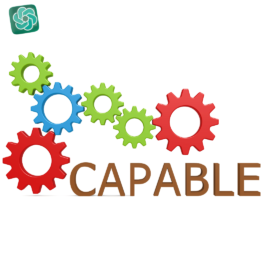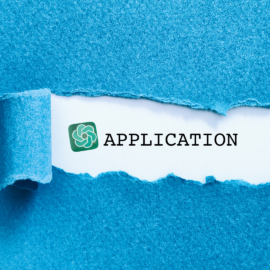GPT-4: New Launch By Open AI
Right Shout
In Uncategorized Posted March 24, 2023
Taking Automation and Machine Learning to the Next Level
GPT-4 is the latest model from OpenAI, the company behind (previous models) GPT-3.5 and its successors. The model promises to be a revolutionary breakthrough in natural language processing (NLP) technology, with improved accuracy and reliability, as well as greater creativity and ability to handle nuanced instructions.
It is designed to be a multimodal model, meaning it can accept image and text inputs in order to generate a text output.
This article will provide an overview of the features, capabilities, and potential applications of GPT-4. We’ll look at how OpenAI has made GPT-4 safer, the multimodal capabilities of the model, and some possible applications.
We’ll also discuss some potential ethical issues that arise when using it. Finally, we’ll wrap up by exploring what makes it unique among NLP models.
By the end of this article, you will have a better understanding of GPT-4 and what it can do.
🚨ChatGPT for Customer Service is Here🚨
— Des Traynor (@destraynor) March 14, 2023
Hot on the heels of the @OpenAI GPT-4 launch, you'll be ꜱʜᴏᴄᴋᴇᴅ to hear that we have a new product release built entirely on GPT-4.
This is perhaps Intercom's biggest new release in our history... pic.twitter.com/TeyfC3AndU
OPEN AI MITIGATIONS FOR SAFETY & SECURITY
OpenAI has taken several measures to ensure that GPT-4 is safe and secure. One of the most important measures is careful risk mitigation. OpenAI has studied how previous models have been misused and made sure to take steps to prevent similar issues with GPT-4.

Additionally, OpenAI has restricted the model’s access to data from after September 2021. This means that GPT-4 won’t be able to “learn” about events or changes in the world since then, which could lead to it making basic reasoning errors.
OpenAI has also taken steps to limit the model’s access to certain sensitive data, such as medical records and financial statements.
MULTIMODAL CAPABILITIES OF GPT-4
GPT-4 has powerful multimodal capabilities, which allow it to accept both image and text inputs and generate natural language outputs. GPT-4 can detect the relations between images and text, allowing it to construct more complex concepts than what could be done with GPT-3.5.

For example, it can identify objects in images and generate descriptions or instructions for performing tasks with those objects. GPT-4 also has the ability to interpret complex instructions such as nested conditional statements, enabling it to have an understanding of nuance that was not possible before.
This makes GPT-4 particularly useful for applications like automatic summarization, machine translation, and question answering systems.
POTENTIAL APPLICATIONS OF GPT-4
One of the potential applications of GPT-4 is natural language processing (NLP). As a large multimodal model, GPT-4 can process text and images to produce more accurate results. This could be useful for automated translations, automatic summarization, question answering systems, and other NLP tasks.

At the heart of GPT-4’s revolutionary capabilities is its ability to understand natural language. This means that even simple sketches can be quickly converted into websites – without any manual coding required. The AI-based natural language understanding allows GPT-4 to interpret user input and understand what it is being asked to do.
By utilizing this technology, web developers and designers are able to create stunning websites with increased speed and accuracy. The natural language understanding also allows GPT-4 to respond to user input quickly and accurately – making it a powerful tool for website creation.
GPT-4 could also be used to generate more accurate search results, and this could result in better user experience.
It could also be used for generation of creative works such as music, art, stories and scripts.
GPT-4’s ability to take text and image inputs and generate outputs can allow it to produce original content that is tailored to the user’s specific needs. This could be particularly helpful for people who want to create original content but lack the necessary skills and knowledge.
It generates more realistic dialogue for virtual agents and chatbots. By using GPT-4 to process text input, these virtual agents and chatbots can understand natural language and respond accordingly. This could be useful in a wide range of applications, such as customer service, online tutoring and medical advice.
ETHICAL CONSIDERATIONS OF USING GPT-4
Using GPT-4, or any other advanced AI technology, comes with ethical considerations that must be kept in mind. While GPT-4 has been designed to help automate tasks and enable more creativity than its predecessor GPT-3.5, the model is still fallible and can produce results with unintended consequences if not monitored correctly. In addition, GPT-4’s reliance on one-shot learning and its limited knowledge of events after September 2021 can lead to errors in reasoning.

OpenAI has worked hard to ensure that GPT-4 is as safe as possible and has implemented several safeguards against misuse of the AI technology. However, it is important for users to be aware of the potential risks and take steps to mitigate them. Ethical considerations around using GPT-4 include ensuring that it is used in a responsible manner, with proper oversight and clear guidelines for what tasks can be delegated to the AI model. It is also essential that users are aware of the limitations of GPT-4 and its risk of making errors, and that steps are taken to ensure the safety of any outputs generated by the model. Finally, users should be aware of potential bias in the data used to train GPT-4, and take precautions to minimize such bias. By accounting for these ethical considerations and taking steps to mitigate potential risks associated with using GPT-4, users can ensure that the AI model is used in a safe, responsible manner.
WHAT MAKES GPT-4 UNIQUE ?
What makes GPT-4 so special is that it can quickly and accurately understand user input – even if it’s just a simple sketch. This means that even the most basic of sketches can be quickly translated into a fully-fledged website – without any coding knowledge required.

Thanks to GPT-4, web developers and designers can get their ideas online faster than ever before, allowing them to create stunning websites with unprecedented speed and accuracy. With this latest technology upgrade, OpenAI is leading the way in AI-based website creation.
OpenAI’s GPT-4 technology is more than just a tool for website creation – it marks a huge milestone in the development of advanced artificial intelligence. The technology has been designed to be able to understand natural language, allowing it to interpret user input with ease.
This means that web developers and designers can use GPT-4 to quickly create complex websites without the need for manual coding. This is a huge step forward in terms of efficiency, as it allows users to get their ideas online faster than ever before.
FAQs
Q1. What is GPT-4?
A1. GPT-4 is the latest model from OpenAI, the company behind GPT-3.5 and its successors. It is a revolutionary breakthrough in natural language processing (NLP) technology, with improved accuracy and reliability as well as greater creativity and ability to handle nuanced instructions.
Q2. How is GPT-4 different from the other models?
A2. GPT-4 is designed to be a multimodal model, meaning it can accept image and text inputs in order to generate a text output. This allows it to better understand context and draw on multiple sources of information to create more nuanced outputs.
Q3. What applications can GPT-4 be used for?
A3. GPT-4 has a variety of potential applications, including natural language processing, question answering, summarization, machine translation, and AI chatbots. It could also be used in computer vision projects such as object detection and segmentation.
Q4. Is GPT-4 safe to use?
A4. OpenAI has made GPT-4 safer by introducing a series of safety checks that prevent it from producing offensive or threatening output, as well as an ethics certification process for its developers to ensure ethical usage of the model. However, GPT-4 is still an AI technology that should be used responsibly and with caution.
Q5. Are there any limitations to GPT-4?
A5. As with any AI model, GPT-4 has its limits. It is not yet able to handle complex tasks or respond to extremely specific instructions, though OpenAI is continually working to improve its capabilities. Additionally, GPT-4 does not yet have the ability to generalize from limited training data, so it may be limited in its ability to handle previously unseen situations.
Q6. How can I get started with GPT-4?
A6. To get started with GPT-4, you should first familiarize yourself with OpenAI’s documentation and examples. If you are planning to use GPT-4 for your own applications, then you can access the model via OpenAI’s API or through one of its partner platforms such as AWS, Google Cloud Platform, and Azure. You can also access GPT-4 through its open source library, GPT-3.5. After that, you can begin experimenting with the model and beginning to develop your own applications.
Q7. Is there a cost associated with using GPT-4?
A7. If accessing GPT-4 via OpenAI’s API, then there is a cost associated with using the model. For more information on pricing, please visit OpenAI’s website. If accessing GPT-4 via its open source library or one of its partner platforms (AWS, Google Cloud Platform, and Azure), then there is no additional cost associated with using the model.
CONCLUSION
GPT-4 is a revolutionary new artificial intelligence language model developed by OpenAI. It is the fourth version of its predecessor GPT-3, and promises to revolutionize computer code by offering natural language processing capabilities that are almost indistinguishable from human speech. With this technology, many real world scenarios can be solved with much more accuracy and reliability than before. One examples of this is Duolingo, a language learning app which has benefited tremendously from GPT-4’s natural language processing capabilities.
GPT-4 offers an unprecedented level of accuracy and reliability due to its ability to accurately predict ahead through human feedback and exhibits a performance that is close to human level on a range of tasks. This model is also fully reliable and accurate in academic benchmarks, and offers a wide range of applications that can be used in many different fields. Furthermore, OpenAI has made sure that GPT-4 does not generate any harmful advice or decisions as it has built-in safety checks to prevent this from happening.
Moreover, GPT-4 offers even more powerful capabilities than its predecessor GPT-3, such as the ability to accurately predict ahead when given a set of instructions and its training performance is also much improved. With these new capabilities, GPT-4 promises to revolutionize many tasks that have previously been difficult for AI models to complete. By taking advantage of GPT-4’s powerful capabilities, businesses and organizations can increase their efficiency and automate tasks that were previously time-consuming or impossible to complete with limited data. As such, GPT-4 is sure to become an invaluable part of any AI strategy in the near future. However, it should be used with caution because this model is still new, and its potential for generating harmful advice has not been fully tested. Therefore, further testing needs to be done before it can be considered as a fully reliable AI tool. Nevertheless, GPT-4 is sure to revolutionize many industries in the near future, thanks to its unparalleled capabilities.
What Marketers Think ?
🚨ChatGPT for Customer Service is Here🚨
— Des Traynor (@destraynor) March 14, 2023
Hot on the heels of the @OpenAI GPT-4 launch, you'll be ꜱʜᴏᴄᴋᴇᴅ to hear that we have a new product release built entirely on GPT-4.
This is perhaps Intercom's biggest new release in our history... pic.twitter.com/TeyfC3AndU
#OpenAI has recently revealed the launch of #GPT4, an advanced #AI language model with the capability of reading and interpreting #images + textual inputs.
— Shiba Doge (@RealShibaDoge) March 15, 2023
🌐 Find us https://t.co/qwqKOQA9c3
Missed #Shiba? Missed #Doge?
Don't miss #ShibaDoge! pic.twitter.com/u3Qzw133OQ





